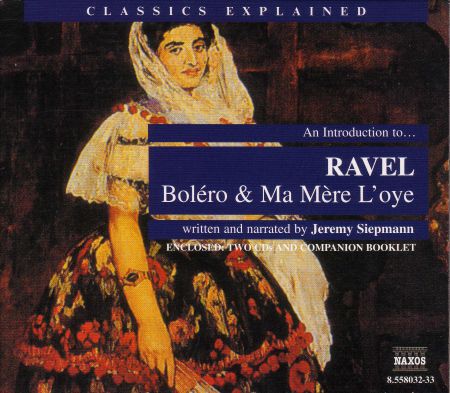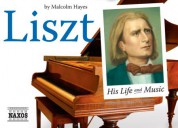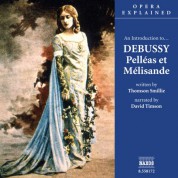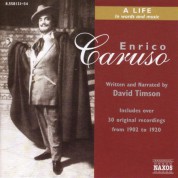
Classics Explained: Ravel - Bolero and Ma Mere L'Oye (Smillie) - CD
Tükendi
Bu Ürün Stoklarımıza Girince Haberdar Olmak İster Misiniz?
(+) Stoklara Girince Haber Ver
(+) Stoklara Girince Haber Ver
Ürün Hakkında
Barkod: 0636943803226
, Katalog No: 8.558032-33 , Firma: Naxos
, Seri: Naxos Classics Explained
, Yayınlanma Tarihi:
16 Temmuz 2001
Format Türü: CD, Format: 2 CD
Eser Listesi
- CD - 1
- An Introduction to … RAVEL: Bolero and Ma Mere L'oye
- 1. Bolero-Introduction; cue to unadorned Bolero rhythm, Part 1
- 00:02:29

- 2. Bolero rhythm, Part 2: an extended variation of Part 1
- 00:00:07

- 3. ' Motto ' rhythm complete
- 00:00:21

- 4. But here we have snare drums and plucked violas and cellos
- 00:00:22

- 5. Section 1: Introduction of ' the theme ' by solo flute
- 00:00:37

- 6. Flute continues with Part 2 of theme
- 00:00:48

- 7. Section 2: Complete statement of theme by clarinet as flute joins ' motto ' group
- 00:01:30

- 8. Introduction of ' discordant ' harp into the unfolding picture
- 00:00:18

- 9. Section 3: Bassoon introduces closely related variant of theme
- 00:00:34

- 10. ...but then veers upwards, slowing rhythm and introducing new syncopation
- 00:00:59

- 11. Section 4: ' Petite ' E flat clainet takes over theme, including variants
- 00:01:21

- 12. Section 5: Oboe d'amore takes over theme but returns to its original form
- 00:01:34

- 13. Section 6: Theme now shared by two instruments: uted trumpet and flute
- 00:01:16

- 14. Section 7: Tenor saxophone takes Theme as trumpet replaces horn in ' motto '
- 00:01:39

- 15. Section 8: Theme taken by soprano saxphone, ' espressivo '
- 00:01:09

- 16. Section 9: Theme: celeste, piccolos and horn; Motto: flute and French horn
- 00:01:24

- 17. Section 10: Theme: Oboes, horns, clarinets; Motto: plucked violas and violins
- 00:02:06

- 18. Section 11: Theme taken by First Trombone, complete with jazzy slides
- 00:01:40

- 19. Section 12: Theme: flutes, oboes, clarinets, sax; Motto: bassoons, horns, trumpets
- 00:01:13

- 20. Section 13: Violins at last take the main tune, joining massed winds
- 00:01:14

- 21. Section 14: Violins divide into four groups, each ' double-stopping '
- 00:01:04

- 22. Section 15: Trumpet, trombone 2 and tuba join the foreground
- 00:01:18

- 23. Section 16: First trombone and soprano saxophone ' rejoin ' theme
- 00:00:56

- 24. Section 17: Fortissimo; all strings ' double-stopping '; trumpets added
- 00:01:26

- 25. Section 18: Entire orchestra now employed, ' as loudly as possible '
- 00:01:18

- 26. Section 19: Sudden, amazing change of key, lurching from C to E Major
- 00:01:20

- 27. Section 20: Key now lurches back to C, as jazzy trombones whiningly protest
- 00:00:36

- 28. Cue to complete performance
- 00:00:20

- 29. Bolero (complete)
- 00:16:16

- CD - 2
- An Introduction to … RAVEL: Bolero and Ma Mere L'oye
- 1. Pavane de la Belle au bois dormant-Opening figure on flute; rising, falling, and then reeated
- 00:01:04

- 2. Same again, with emphasis on delicacy of scoring
- 00:00:30

- 3. answering variant, accompanied by plucked double basses
- 00:00:19

- 4. Reminder of opening figure
- 00:00:18

- 5. ... and now its rhythmical mirror image, or almost...
- 00:00:12

- 6. Answering Phrase 2: a near-inversion, over ' James Bond ' accompaniment
- 00:00:41

- 7. Pivotal Phrase 3, reversing direction but keeping rhythm of Phrase 2
- 00:00:46

- 8. Reprise of Phrases 1 and 2, but with new accompaniment
- 00:00:39

- 9. Further Reprise of Phrase 2, now on violin, accompanied by harp
- 00:00:40

- 10. Pavane (complete)
- 00:01:41

- 11. Petit Poucet (Tom Thumb)-Introduction; Opening, with multi-metre rising scales from muted violins
- 00:00:49

- 12. Change of metre continue as solo oboe introduces Theme One
- 00:00:24

- 13. Oboe yields to Cor Anglais for Theme Two, against lower (still muted) strings
- 00:00:44

- 14. Theme One returns, shared by clarinet and flute, muted horn added to accompaniment
- 00:00:25

- 15. 'Motto' rhythm dominates as intensity increases from lower strings to full orchestra
- 00:00:46

- 16. Fear subsides as Theme Two returns, again in Cor Anglais but now in a different key
- 00:00:32

- 17. Sensational sound effects evoke a wood at night, with screeches, cuckooing etc.
- 00:00:44

- 18. Texture thins; Theme one returns, delicately scored for strings and piccolo
- 00:00:19

- 19. The main part of movement ends, with waltz-like march(!), featuring flute
- 00:00:28

- 20. Petit Poucet (complete)
- 00:03:28

- 21. Laideronnette, Imperatrice des Pagodes-Introduction; opening bars, followed by Theme One
- 00:02:00

- 22. Oriental-orchestral equivalent of an imprial telephone bell
- 00:00:15

- 23. ... oboe ' answers ' with a very slightly varied version of Theme One
- 00:00:15

- 24. Expanded derivative of the ' telephone bell ' interrupts the theme again
- 00:01:00

- 25. Fragments of theme in flutes and cor anglais, with ' James Bond ' tag in violins
- 00:00:24

- 26. 'Gamelan ' music from flute and piccolo, accompanied by harp, xylophone and strings
- 00:00:32

- 27. arrival of Empress; upper strings yield to winds, celeste, harp and (very discreet) gong
- 00:00:47

- 28. Laideronnette, Imperatrice des Pagodes (complete)
- 00:03:57

- 29. Les entretiens de la Belle et de la Bete- opening
- 00:00:51

- 30. Characteristic pattern of two short phrases answered by a long one
- 00:00:36

- 31. Clarinet, flutes and violas, with ' sighing' figure derived from downward string motif
- 00:00:21

- 32. Varied reprise of opening, entry of the ' Beast '; ' Watch it ! Watch it ! '
- 00:00:32

- 33. Again the ' Beast ' growls; again the cautious warning ' Watch it ! ' from the winds
- 00:00:40

- 34. Derivative of Beauty's Theme from flute, combined with ' caution motif ' in strings
- 00:00:38

- 35. ' Beast's theme ' rises in pitch with each successive ' gowl ' (representing hope?)
- 00:00:52

- 36. ' Beauty ', ' Beast ' and ' Caution ' motifs all combine simultaneously
- 00:01:12

- 37. ' Beast ' (contra-bassoon) climbs ever higher, handing over to bassoon proper
- 00:00:49

- 38. Harp's upward glide heralds the moment of transformation; love song, fear, release
- 00:02:09

- 39. Les entretiens de la Belle et de la Bete (complete)
- 00:04:14

- 40. Le jardin feerique-Introduction; Opening bars are unfuuuuuuuuurled by the strings alone
- 00:00:40

- 41. The rhythmic basis, and its guises. First, a question: ' Where went my childhood?'
- 00:01:23

- 42. The question intensified:' Oh where went ... my childhood?'
- 00:00:15

- 43. The answer, with a falling inflection: ' Gone is your childhood.'
- 00:00:20

- 44. The plea: ' Bring back my childhood!'
- 00:00:14

- 45. The response: ' Seek in ... your mem'ry. There it ... will be.'
- 00:00:25

- 46. Ravel's use of tone colour to change the feeling of the music
- 00:00:49

- 47. Further illustration of the same point
- 00:00:27

- 48. Continued
- 00:01:44

- 49. The nobility of the strings
- 00:00:45

- 50. Bells evoked by French horns; the final, opulent, moving climax of the whole suite
- 00:01:11

- 51. Le jardin feerique (complete)
- 00:04:00

Katkıda Bulunanlar
|
Bu Ürünler İlginizi Çekebilir










